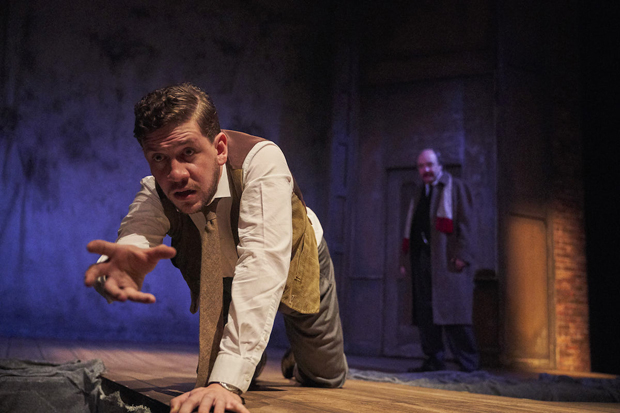A Spooky Story Sets the Scene for The Woman in Black
The Pasadena Playhouse production will have even skeptics believing in ghosts.

(© Roger Mastroianni)
An evening of chills, giggles, and parlor tricks are on offer in Stephen Mallatratt's The Woman in Black, which serves up the perfect treat for the Halloween season. Palatable for teens but creepy enough for adults, the play is a pageant of all the elements that startle skittish mortals.
Two English gentlemen sit in an empty theater and rehearse a new project. Arthur Kipps (Bradley Armacost) had witnessed true horror in his younger days, and now, in his twilight years, he desperately feels the need to share that experience with the world. At the beginning of his career, Kipps, a solicitor, had landed a client, who recently died, alone, in an eerie old house. He visits the estate to attend the funeral and wade through her paperwork and belongings. Though he sits in the dark unaccompanied, he is not the only presence in the house. Shadows on the wall, moving objects, diabolical sounds all herald a vindictive specter. The Actor (Adam Wesley Brown) aids Kipps by rewriting the text and bringing this fanciful and deadly event to the stage.
Adapting Susan Hill's novel, Mallatratt achieves more than merely enacting a tale of terror for Halloween scares. By framing the story with the two performers shaping it, The Woman in Black is a meditation on passing folklore. The elements found in the best ghost stories are here, while repetition and a hammering of a specific moment in time vividly set the scene for the audience. The play even mocks those tenets as the Actor demands Kipps repeat his first line over and over so his dull tones will bore the audience. Kipp's tale, and his desperation to pass it along, grants the play depth beyond a simple horror story.
Both Armacost and Brown ground the production with realism and a palpable chemistry. Their interactions form a friendship, as mentor and student both learn from each other. Brown, as the Actor, takes the role of Kipp in their play-within-a-play, demonstrating resoluteness of a lawyer finding facts that defy logic. Armacost, as Kipp, gets to play all the peripheral roles in their drama and has some particularly humorous moments playing fuddy-duddies and parochial eccentrics.
Director Robin Herford paints a murky, desolate sense of dread without the aid of much stagecraft. The sparse set by Michael Holt uses scrims to portray the malevolence seeping through the walls of the gothic house. Gareth Owen's sound effects and Kevin Sleep's lighting brings the creaks and shadows to wraithlike life. As the climax arrives, though, Herford's pacing begins to run out of steam. The horrific finale, which should have shattered the audience, was not staged to achieve maximum effect.
The Woman in Black works as a theatrical event and evokes a communal horror experience for a live audience. The spooks trigger screams from unsuspecting audience members, which in turn, leads to laughter from everyone for allowing a few tricks to taunt and startle them. In short, it's a real Halloween treat.








